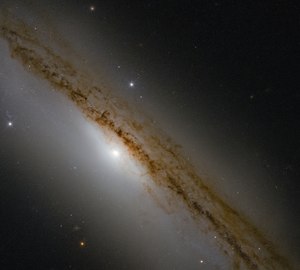NGC 1589
| Galaxy NGC 1589 |
|
|---|---|

|
|
| Image of the galaxy NGC 1589 using the Hubble Space Telescope | |
| AladinLite | |
| Constellation | bull |
|
Position equinox : J2000.0 , epoch : J2000.0 |
|
| Right ascension | 04 h 30 m 45.44 s |
| declination | + 00 ° 51 ′ 49.2 ″ |
| Appearance | |
| Morphological type | Sab |
| Brightness (visual) | 12.0 mag |
| Brightness (B-band) | 12.8 mag |
| Angular expansion | 3.2 ′ × 1.0 ′ |
| Position angle | 160 ° |
| Surface brightness | 13.1 mag / arcmin² |
| Physical data | |
| Affiliation | NGC 1587 group NGC 1588 group NGC 1589 group LGG 117 |
| Redshift | 0.012652 ± 0.000080 |
| Radial velocity | 3793 ± 24 km / s |
|
Stroke distance v rad / H 0 |
(167 ± 12) · 10 6 ly (51.1 ± 3.6) Mpc |
| history | |
| discovery | William Herschel |
| Discovery date | December 19, 1783 |
| Catalog names | |
| NGC 1589 • UGC 3065 • PGC 15342 • CGCG 393-030 • MCG + 00-12-038 • 2MASX J04304545 + 0051491 • GC 860 • H II 7 • h 318 • SDSS J043045.45 + 005149.2 • NSA 133838 • LDCE 311 NED004 • WISEA J043045.44 + 005149.1 | |
NGC 1589 is a spiral galaxy of Hubble type Sab in Taurus on the ecliptic . It is an estimated 167 million light years from the Milky Way and about 160,000 light years in diameter .
In the same area of the sky are u. a. the galaxies NGC 1587 , NGC 1588, and NGC 1593 .
The Type Ia supernova SN 2001eb was observed here.
The object was discovered by Wilhelm Herschel on December 19, 1783 .
SDSS recording

